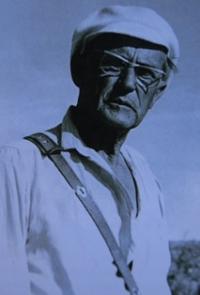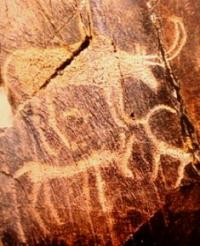You are here
Koybagar petroglyphs.


Research tours on petroglyphs Southern Kazakhstan.
"In small ravines along the Karakuyis River bed, shielded from the winds, are tens of dwelling sites dating to the XVIIIth - early XXth centuries, and, possibly, other later settlements.
Petroglyphs dated to the Bronze Age and the early XXth century stand out"
Photos of petroglyphs of Kazakhstan.
Koybagar Gorge is located 30km north of Arpauzen, 5km west of Kozmoldak Village. The petroglyph site is at the mouth of a deep gorge, on the left side of the Karakuyis River valley and its wide delta in the foothill uplands.
The erosion of the ancient surface resulted in a chain of small hills, on the slopes of which are scatterings of boulders with petroglyphs covered with “desert patina”. As at Arpauzen, the site was, for the first time, explored in 1970 - 1971 by the Karaut Party of the Southern Kazakhstan Archeological Expedition led by Kadyrbaev M.K. and Maryashev A.N.
Those pioneers identified three main concentrations of petroglyphs near the mouth of Karakuiz Gorge – Koybagar I-III. The petroglyphs are pecked on individual boulders located on the slopes of three hills with flat tops (Kadyrbaev & Maryashev 1977).
In 2003 - 2004, the Koybagar petroglyphs were explored by Rogozhinskiy A.-E. as part of the UNESCO carad Project. The geographic coordinates of the main petroglyph sites were recorded, and photos and copies of more than 130 boulders with images were made.
A small concentration of petroglyphs exists on the southern and southwestern slopes of the hills. Multiple kurgan burial sites of ancient and medieval nomads are well preserved on the flat tops of the hills and along the mouth of the gorge.
In small ravines along the Karakuyis River bed, shielded from the winds, are tens of dwelling sites dating to the XVIIIth - early XXth centuries, and, possibly, other later settlements.
Petroglyphs dated to the Bronze Age and the early XXth century stand out.
The most ancient are distinguished by their wide variety, with a bull and “spectacle-shaped” signs (two circles connected with a line). Late Bronze Age ones include many scenes with battle chariots and combat motifs.
A chariot driven by two horses is rare in rock art. Bronze Age petroglyphs predominate over Early Iron Age and Medieval ones. The last burst of intensive pictorial activity in Koybagar dates to Late Middle Ages and modernity or the XVIIth – early XXth century.
Authority:
“Rock Art Sites in Kazakhstan”. Alexey E. Rogozhinskiy.







